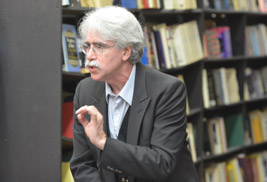Featured Article
From Cornfields to Kent State: Researcher Demonstrates Fracking Produces Less Wastewater Than Conventional Drilling
For Brian Lutz, Ph.D., a native of Lordstown, Ohio, what started out as a curiosity while working on his family farm has led him to where he is now: asking critical research questions on fracking and shale gas issues that can affect millions of people in his home state.
read moreKent State University Professor Teaches Class on Vampires
Posted Feb. 25, 2013 | Megan Tomkins
Mark Dawidziak, author and instructor with Kent State
University’s School of Journalism and Mass Communication,
teaches a “Vampires on Film and Television” class.
Pop culture is inundated with images of vampires in print and on screen. From sparkling immortals to devious bloodsuckers, Twilight to The Vampire Diaries, True Blood and more, the vampire theme seems to resonate well with audiences.
Recognizing the popularity of this subject matter, Mark Dawidziak, author and instructor with Kent State University’s School of Journalism and Mass Communication, teaches a “Vampires on Film and Television” class. Dawidziak began teaching this class at Kent State in the fall of 2009. He also is the television critic at The Plain Dealer.
Some may believe that the vampire craze is at an all-time high, but after years of research, Dawidziak says the obsession with vampires has peaked several times throughout history.
“Vampires have always been popular,” says Dawidziak, whose books include The Bedside, Bathtub & Armchair Companion to Dracula. “Since 1819, there have been almost 200 uninterrupted years where vampires have dominated the stage, publishing, film or whatever pop culture was at the time.”
Dawidziak teaches his students, not only the pop-culture aspect of the vampire myths, but also the culture’s history and what was going on in each decade, which directly correlates with how society has viewed vampires.
“We start with all the original myths and legends and folklore,” Dawidziak says. “Every society, continent and culture has a form of the vampire myth. Vampires are the most pervasive and enduring myth. When you examine the hopes, dreams, despair within a generation, vampires are there. There’s a reason a vampire looks the way he or she does in each decade. They mirror the culture at the time. There’s a metaphoric need for a vampire to look and act this way. The vampire doesn’t shape the culture, the culture shapes the vampire.”
Through his research, Dawidziak believes the past 90 years have humanized and romanticized the vampire.
“Over the course of those 90 years we have made them look more like us,” says Dawidziak. “They are less a thing of nightmares and now more a thing of dreams. We still have nasty and repugnant vampires, but they no longer look like the middle-aged, white men vampires from the ’70s era.”
One of Dawidziak’s students, Ben Chronister, a senior secondary education major, found the class to be not only informative, but also useful for his future profession.
“As an education major, I am always looking for new ways to introduce multimedia into the classroom,” Chronister says. “I was curious to learn what, if any, academic value might be pulled out of vampire movies. As it turns out, it’s a pretty fascinating topic.”
Chronister was surprised that after years of his own fascination with vampires, he still had much to learn.
“The most interesting thing I learned was that vampire movies are older than I realized and are a fantastic way of examining the fears and hopes of the eras in which those films were produced,” Chronister says.
Chronister believes Dawidziak is well-informed on the topic of vampires and an excellent professor.
“I would recommend this class to other people,” says Chronister. “If nothing else, Dawidziak’s lectures are worth the price of admission, but the movies and overall structure of the class lead to some pretty cool conclusions.”
Dawidziak is currently teaching the class this spring semester. For more information about the class, email him at mdawidzi@kent.edu.
For more information about the School of Journalism and Mass Communication, visit http://jmc.kent.edu.
